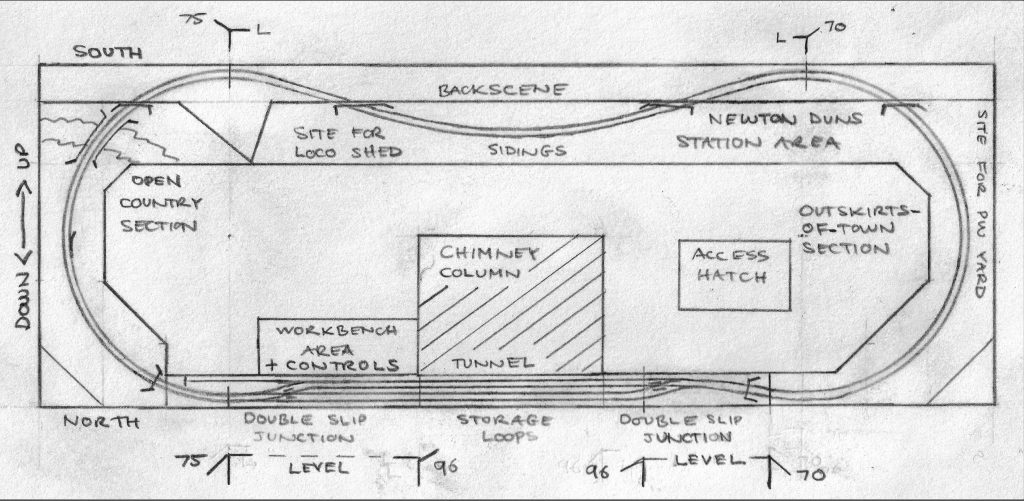Alasdair Taylor describes his layout, Newton Duns.
- Layout size: 25’ x 9’, continuous-run double track main line;
- Location: Newton Duns is a fictitious “small town somewhere in the Central Borders, situated on the Waverley Route”;
- Era: BR Scottish Region, nominally Spring 1961, but in practice any time from the late 1950s up to about 1966-67;
- Baseboards: mostly traditional 2”x1” softwood framing variously topped by ½” insulation board, Sundeala, or 6mm MDF;
- Trackwork: plain line is largely C&L laid on Carr’s cork strip, with pointwork mostly constructed using the ply-and-rivet method. Minimum curve radius 4’ or B6 turnout;
- Control: conventional analogue DC using Gaugemaster handheld units;
- Locos and rolling-stock: rewheeled RTR and kitbuilt, recreating typical trains to be seen working over the Waverley Route;
- Couplings: mostly Alex Jackson, but some scale screw and 3-link. As far as possible, all stock has buffer-beam draw-hooks, so in theory anything should couple to anything else !
These are the key points. Because it’s a permanent fixture in the loft, Newton Duns won’t appear on the exhibition circuit, but it was described in some detail in ScaleFour News 177 back in May 2012 and bits have also appeared as background to model locomotive pics in places like RMWeb. Previously I described the layout as a “Work in Progress”, and essentially it still is… I’d have to admit that it hasn’t developed a lot since then, and as it’s usually employed to road-test my (and from time-to-time other people’s) latest creations of P4 locomotives and rolling stock it’s really more of a glorified test track ! So what “Work in Progress” really means is “lots of Work to do, not much Progress….”
Time was when the traditional roundy-roundy layout was rather frowned upon by the more discerning modeller. But there’s no doubt that it’s absolutely ideal for testing and running in new rolling-stock – especially P4 locomotives under construction, as that leads to identification and, one hopes, resolution of chassis etc problems at an early stage.

The only part of the layout which has been scenically developed so far is the “open country” section, though there’s still some work to do here. This section represents part of the Waverley Route descending south from Falahill summit through the valley of the Gala Water towards Galashiels. One of the distinctive features of this stretch is the number of “hogs-back” plate-girder underbridges where the line crosses and recrosses the Gala Water: rather surprisingly, most were left in situ after the track was lifted following closure in 1969, and this had two advantages – a mate and I were able to make a fairly detailed survey of bridge 56 near Fountainhall Junction around 1997, and more recently when the Borders Railway was being constructed this bridge and others were found to be in re-usable condition. A representation of bridge 56 features in this part of the layout: the girder spans are scratch-built from plasticard of various sections, including the infuriatingly tiny gussets for the strengthening ribs ! The occupation bridge forming the northern scenic break replicates bridge 46 near Heriot, and the idea for the overbridge at the other end immediately after the river bridge is taken from “Plumtreehall Brae” just south of Kilnknowe Junction in the northern outskirts of Galashiels.

But really there’s nothing quite like simply being able to “watch the trains go by”, so let’s take a trip back in time with our duffel bags, sandwiches, bottles of Tizer, notebooks, ABCs, Ilford “Sportsman” or Kodak “Retinette” cameras, and settle down by the lineside near the Newton Duns Up Distant to see what trains appear… no Real Time Trains in those days!
For those who might like more information on the locomotives seen –
| Origin | Class | Number | Loco Details |
| Ex-LNER | A1 | 60159 | DJH Kit built by Allan Sibley |
| Ex-LNER | B1 | 61099 | Replica / Comet, built by Allan Sibley |
| Ex-LNER | K3 | 61823 | SEFinecast kit built by Allan Sibley |
| Ex-NBR | J35 | 64532 | DJH Kit, chassis built by Don Rowland |
| Ex-NBR | J37 | 64591 | NB Models kit / Eastfield Models chassis |
| Ex-NBR | J37 | 64608 | NB Models kit / Eastfield Models chassis |
| Ex-NBR | J36 | 65258 | Gem kit / Eastfield Models chassis |
| BR Standard | 7MT | 70016 | Hornby RTR rewheeled for P4 |
| BR Standard | 4MT | 80113 | Bachmann RTR rewheeled for P4 |
| Brush/Sulzer | Type 4 | D1517 | Heljan RTR rewheeled for P4 |
| Brush/Sulzer | Type 4 | D1974 | Heljan RTR rewheeled for P4 |
| English Electric | Type 4 | D363 | Bachmann RTR rewheeled for P4 |
| English Electric | Type 3 | D6850 | Triang body on Lima chassis: (first P4 loco) |
Acknowledgements: Usual disclaimers regarding products mentioned. My thanks to fellow-members of the East of Scotland 4mm Group for encouragement, advice and assistance, and in particular to Allan Goodwillie for painting the Gala Water Valley backscene and help with the scenery. And thanks also to Jim Summers and the VS4NI team for inviting Newton Duns to appear here, thus providing me with a powerful incentive to make constructive progress with the layout. Most importantly, thanks to my wife Anthea for support and encouragement.
